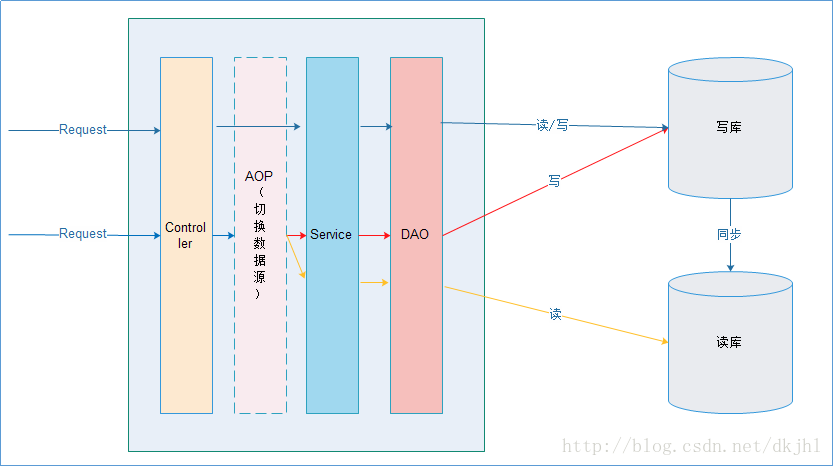spring完美实现读写分离+mysql实现主从复制
在“cool-2018-03-10-windows下实现mysql5.6读写分离、主从复制和一主多从”这篇博文上实现了物理环境,博文地址:读写分离,接下来在代码层面实现
1. 背景
我们一般应用对数据库而言都是“读多写少”,也就说对数据库读取数据的压力比较大,有一个思路就是说采用数据库集群的方案,
其中一个是主库,负责写入数据,我们称之为:写库;
其它都是从库,负责读取数据,我们称之为:读库;
那么,对我们的要求是:
1、 读库和写库的数据一致;
2、 写数据必须写到写库;
3、 读数据必须到读库;
2. 方案
解决读写分离的方案有两种:应用层解决和中间件解决。
2.1. 应用层解决:
优点:
1、 多数据源切换方便,由程序自动完成;
2、 不需要引入中间件;
3、 理论上支持任何数据库;
缺点:
1、 由程序员完成,运维参与不到;
2、 不能做到动态增加数据源;
2.2. 中间件解决
优缺点:
优点:
1、 源程序不需要做任何改动就可以实现读写分离;
2、 动态添加数据源不需要重启程序;
缺点:
1、 程序依赖于中间件,会导致切换数据库变得困难;
2、 由中间件做了中转代理,性能有所下降;
相关中间件产品使用:
mysql-proxy:http://hi.baidu.com/geshuai2008/item/0ded5389c685645f850fab07
Amoeba for MySQL:http://www.iteye.com/topic/188598和http://www.iteye.com/topic/1113437
3. 使用Spring基于应用层实现
3.1. 原理
在进入Service之前,使用AOP来做出判断,是使用写库还是读库,判断依据可以根据方法名判断,比如说以query、find、get等开头的就走读库,其他的走写库。
4、一主多从的实现

代码层面的具体实现:
第一步:编写DynamicDataSource2类,由于很多应用场景都是采用“一主多从”的架构,所以这个类实现了对这个架构的支持,并且该类中的轮询算法实现了负载均衡
package com.elegant.datasource;
import java.lang.reflect.Field;
import java.util.ArrayList;
import java.util.List;
import java.util.Map;
import java.util.concurrent.atomic.AtomicInteger;
import javax.sql.DataSource;
import org.slf4j.Logger;
import org.slf4j.LoggerFactory;
import org.springframework.jdbc.datasource.lookup.AbstractRoutingDataSource;
import org.springframework.util.ReflectionUtils;
/**
* 定义动态数据源,实现通过集成Spring提供的AbstractRoutingDataSource,只需要实现determineCurrentLookupKey方法即可
*
* 由于DynamicDataSource是单例的,线程不安全的,所以采用ThreadLocal保证线程安全,由DynamicDataSourceHolder完成。
*
* DynamicDataSource2
* 创建人:cool
* 时间:2018年3月10日-下午4:21:52
* @version 1.0.0
*
*/
public class DynamicDataSource2 extends AbstractRoutingDataSource {
private static final Logger LOGGER = LoggerFactory.getLogger(DynamicDataSource.class);
private Integer slaveCount;
// 轮询计数,初始为-1,AtomicInteger是线程安全的
private AtomicInteger counter = new AtomicInteger(-1);
// 记录读库的key
private List第二步:编写DynamicDataSourceHolder类
package com.elegant.datasource;
/**
* 使用ThreadLocal技术来记录当前线程中的数据源的key
*
* DynamicDataSourceHolder
* 创建人:cool
* 时间:2018年3月10日-下午4:13:52
* @version 1.0.0
*
*/
public class DynamicDataSourceHolder {
//写库对应的数据源key
// private static final String MASTER = "master";
// 写库对应的数据源key
public static final String MASTER = "master";
//读库对应的数据源key
private static final String SLAVE = "slave";
//使用ThreadLocal记录当前线程的数据源key
private static final ThreadLocal holder = new ThreadLocal();
/**
* 设置数据源key
* @param key
*/
public static void putDataSourceKey(String key) {
holder.set(key);
}
/**
* 获取数据源key
* @return
*/
public static String getDataSourceKey() {
return holder.get();
}
/**
* 标记写库
*/
public static void markMaster(){
putDataSourceKey(MASTER);
}
/**
* 标记读库
*/
public static void markSlave(){
putDataSourceKey(SLAVE);
}
/**
* 判断是否为主数据库
*/
public static boolean isMaster() {
return MASTER.equals(getDataSourceKey());
}
}
第三步:编写DataSourceAspect2类
package com.elegant.datasource;
import java.lang.reflect.Field;
import java.util.ArrayList;
import java.util.List;
import java.util.Map;
import org.apache.commons.lang3.StringUtils;
import org.aspectj.lang.JoinPoint;
import org.springframework.transaction.interceptor.NameMatchTransactionAttributeSource;
import org.springframework.transaction.interceptor.TransactionAttribute;
import org.springframework.transaction.interceptor.TransactionAttributeSource;
import org.springframework.transaction.interceptor.TransactionInterceptor;
import org.springframework.util.PatternMatchUtils;
import org.springframework.util.ReflectionUtils;
/**
* 定义数据源的AOP切面,该类控制了使用Master还是Slave。
*
* 如果事务管理中配置了事务策略,则采用配置的事务策略中的标记了ReadOnly的方法是用Slave,其它使用Master。
*
* 如果没有配置事务管理的策略,则采用方法名匹配的原则,以query、find、get开头方法用Slave,其它用Master。
*
* DataSourceAspect2
* 创建人:cool
* 时间:2018年3月10日-下午4:25:11
* @version 1.0.0
*
*/
public class DataSourceAspect2 {
private List slaveMethodPattern = new ArrayList();
private static final String[] defaultSlaveMethodStart = new String[]{ "query", "find", "get" };
private String[] slaveMethodStart;
/**
* 读取事务管理中的策略
*
* @param txAdvice
* @throws Exception
*/
@SuppressWarnings("unchecked")
public void setTxAdvice(TransactionInterceptor txAdvice) throws Exception {
if (txAdvice == null) {
// 没有配置事务管理策略
return;
}
//从txAdvice获取到策略配置信息
TransactionAttributeSource transactionAttributeSource = txAdvice.getTransactionAttributeSource();
if (!(transactionAttributeSource instanceof NameMatchTransactionAttributeSource)) {
return;
}
//使用反射技术获取到NameMatchTransactionAttributeSource对象中的nameMap属性值
NameMatchTransactionAttributeSource matchTransactionAttributeSource = (NameMatchTransactionAttributeSource) transactionAttributeSource;
Field nameMapField = ReflectionUtils.findField(NameMatchTransactionAttributeSource.class, "nameMap");
nameMapField.setAccessible(true); //设置该字段可访问
//获取nameMap的值
Map map = (Map) nameMapField.get(matchTransactionAttributeSource);
//遍历nameMap
for (Map.Entry entry : map.entrySet()) {
if (!entry.getValue().isReadOnly()) {//判断之后定义了ReadOnly的策略才加入到slaveMethodPattern
continue;
}
slaveMethodPattern.add(entry.getKey());
}
}
/**
* 在进入Service方法之前执行
*
* @param point 切面对象
*/
public void before(JoinPoint point) {
// 获取到当前执行的方法名
String methodName = point.getSignature().getName();
boolean isSlave = false;
if (slaveMethodPattern.isEmpty()) {
// 当前Spring容器中没有配置事务策略,采用方法名匹配方式
isSlave = isSlave(methodName);
} else {
// 使用策略规则匹配
for (String mappedName : slaveMethodPattern) {
if (isMatch(methodName, mappedName)) {
isSlave = true;
break;
}
}
}
if (isSlave) {
// 标记为读库
DynamicDataSourceHolder.markSlave();
} else {
// 标记为写库
DynamicDataSourceHolder.markMaster();
}
}
/**
* 判断是否为读库
*
* @param methodName
* @return
*/
private Boolean isSlave(String methodName) {
// 方法名以query、find、get开头的方法名走从库
return StringUtils.startsWithAny(methodName, getSlaveMethodStart());
}
/**
* 通配符匹配
*
* Return if the given method name matches the mapped name.
*
* The default implementation checks for "xxx*", "*xxx" and "*xxx*" matches, as well as direct
* equality. Can be overridden in subclasses.
*
* @param methodName the method name of the class
* @param mappedName the name in the descriptor
* @return if the names match
* @see org.springframework.util.PatternMatchUtils#simpleMatch(String, String)
*/
protected boolean isMatch(String methodName, String mappedName) {
return PatternMatchUtils.simpleMatch(mappedName, methodName);
}
/**
* 用户指定slave的方法名前缀
* @param slaveMethodStart
*/
public void setSlaveMethodStart(String[] slaveMethodStart) {
this.slaveMethodStart = slaveMethodStart;
}
public String[] getSlaveMethodStart() {
if(this.slaveMethodStart == null){
// 没有指定,使用默认
return defaultSlaveMethodStart;
}
return slaveMethodStart;
}
}
第四步:配置两个数据源--db.properties
jdbc.master.driver=com.mysql.jdbc.Driver
jdbc.master.url=jdbc:mysql://127.0.0.1:3380/elegant?useUnicode=true&characterEncoding=utf8&autoReconnect=true&allowMultiQueries=true
jdbc.master.username=root
jdbc.master.password=root
jdbc.slave01.driver=com.mysql.jdbc.Driver
jdbc.slave01.url=jdbc:mysql://127.0.0.1:3381/elegant?useUnicode=true&characterEncoding=utf8&autoReconnect=true&allowMultiQueries=true
jdbc.slave01.username=root
jdbc.slave01.password=root第五步:连接池配置+配置自己的数据源--applicationContext-dao.xml
第六步:配置事物管理以及动态切换数据源切面--applicationContext-trans.xml,这里的切面做了改进,使用的是事物管理策略中的规则匹配,这个比通过方法名匹配来得灵活,不需要硬编码。
至此基于应用层的读写分离的解决方案完美实现


